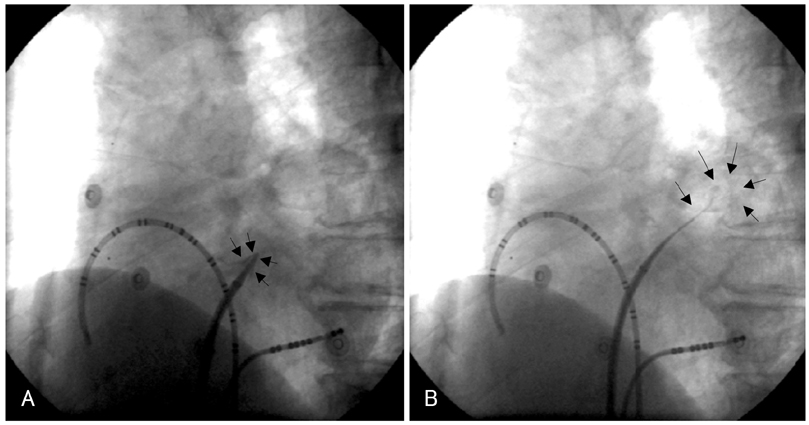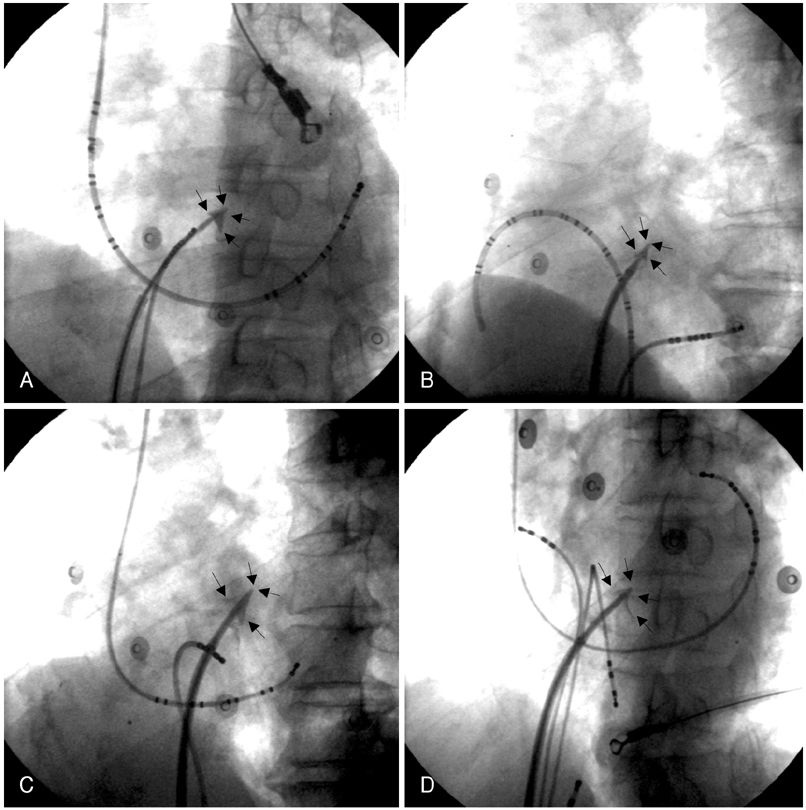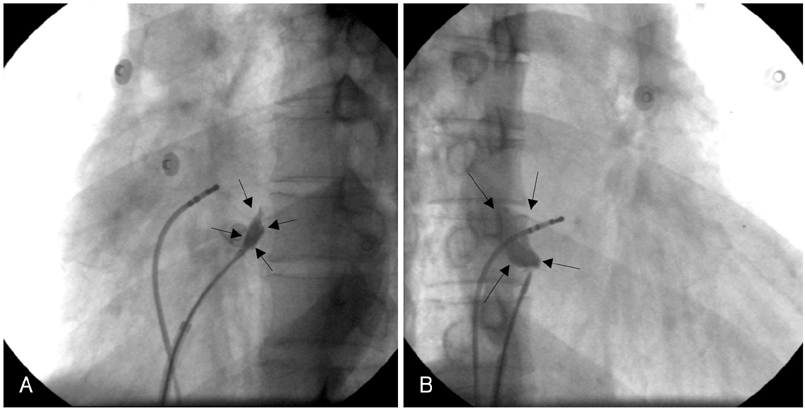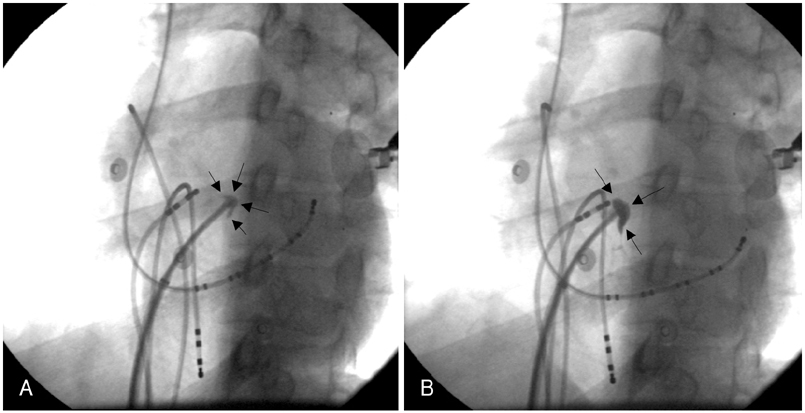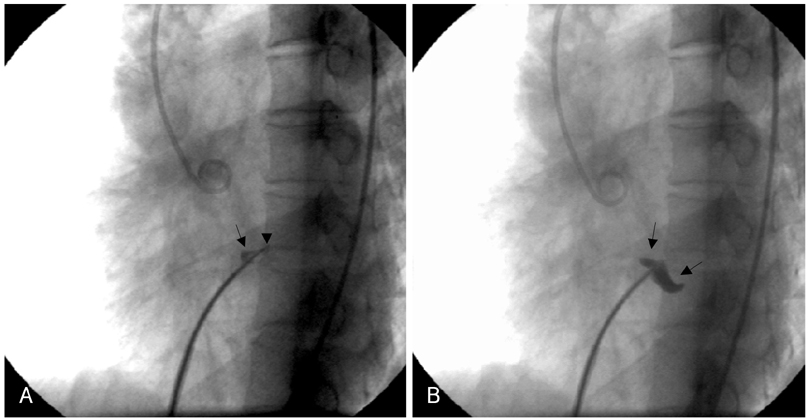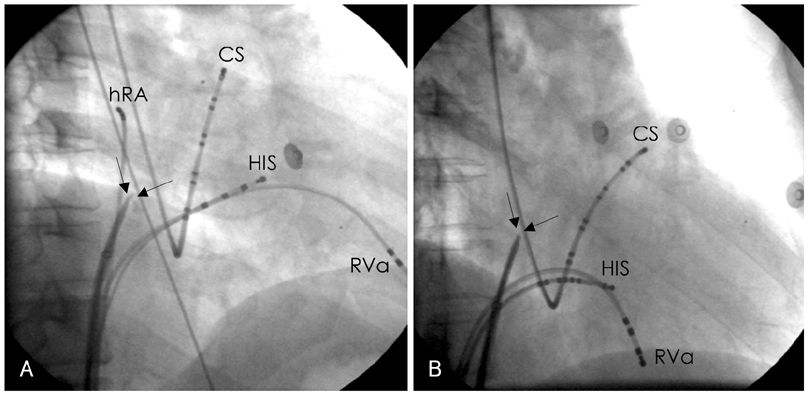Korean Circ J.
2008 Oct;38(10):544-550. 10.4070/kcj.2008.38.10.544.
Experience With Using a Safe Landmark the Fossa Ovalis in Transseptal Procedures
- Affiliations
-
- 1Division of Cardiology, Department of Internal Medicine, Research Institute of Clinical Medicine, Chonbuk National University Medical School, Jeonju, Korea. ksee@chonbuk.ac.kr
- KMID: 2225719
- DOI: http://doi.org/10.4070/kcj.2008.38.10.544
Abstract
- BACKGROUND AND OBJECTIVES
Pressure monitoring and injection of contrast media after piercing the fossa ovalis are used to avoid life-threatening complications during transseptal procedures. However, when performing those maneuvers, the information provided can only be obtained after having pierced structures that may not have been the intended target. When we injected the contrast media through a Brockenbrough needle before piercing the fossa, the dye that had collected under the membranous septum tented by the transseptal equipment (tenting) was observed on the left anterior oblique (LAO) projection and this indicated the fossa ovalis. This study was performed to evaluate the usefulness and safety of tenting in order to identify the membranous septum during transseptal procedures. SUBJECTS AND METHODS: Contrast injections were performed on the fossa ovalis and the septal wall surrounding it during 64 transseptal procedures. The rates of dye staining and tenting in both the muscular and membranous septums were compared. RESULTS: No areas of the muscular septum exhibited any tenting. Various rates of dye staining of those areas were observed. However, the membrane of the fossa exhibited tenting without dye staining in all 64 cases. The sensitivity of the tenting without dye staining to identify the Fossa was 98%, and the specificity was 100%. CONCLUSION: Tenting without dye staining could differentiate the membranous septum from the muscular one with high diagnostic accuracy. This method could be used as a safe landmark for the fossa ovalis before piercing it during transseptal procedures.
Keyword
MeSH Terms
Figure
Reference
-
1. De Ponti R, Cappato R, Curnis A, et al. Trans-septal catheterization in the electrophysiology laboratory: data from a multicenter survey spanning 12 years. J Am Coll Cardiol. 2006. 47:1037–1042.2. Cope C. Technique for transseptal catheterization of the left atrium: preliminary report. J Thorac Surg. 1959. 37:482–486.3. Ross J Jr, Braunwald E, Morrow AG. Transseptal left atrial puncture: new technique for the measurement of left atrial pressure in man. Am J Cardiol. 1959. 3:653–655.4. Ross J Jr, Braunwald E, Morrow AG. Left heart catheterization by the transseptal route: a description of the technique and its applications. Circulation. 1960. 22:927–934.5. Brockenbrough EC, Braunwald E. New technique for left ventricular angiocardiography and transseptal left heart catheterization. Am J Cardiol. 1960. 6:1062–1064.6. Brokenbrough EC, Braunwald E, Ross J Jr. Transseptal left heart catheterization: a review of 450 studies and description of an improved technique. Circulation. 1962. 25:15–21.7. Shaw TR. Anterior staircase manoeuvre for atrial transseptal puncture. Br Heart J. 1994. 71:297–301.8. Inoue K. Percutaneous transvenous mitral commissurotomy using the Inoue balloon. Eur Heart J. 1991. 12:B. 99–108.9. Yoon JH, Park KS, Choi KH, Hwang SO. Percutaneous balloon mitral valvuloplasty in patient with mitral stenosis and kyphoscoliosis. Korean Circ J. 1993. 23:320–324.10. Shin YJ, Shim WH, Yoon YS, Chung NS. Percutaneous balloon mitral valvuloplasty in pregnancy. Korean Circ J. 1992. 22:858–862.11. Ballal RS, Mahan EF 3rd, Nanda NC, Dean LS. Utility of transesophageal echocardiography in interatrial septal puncture during percutaneous mitral balloon commissurotomy. Am J Cardiol. 1990. 66:230–232.12. Hung JS, Fu M, Yeh KH, Chua S, Wu JJ, Chen YC. Usefulness of intracardiac echocardiography in transseptal puncture during percutaneous transvenous mitral commissurotomy. Am J Cardiol. 1993. 72:853–854.13. Park SH, Kim MA, Hyon MS. Percutaneous balloon mitral valvuloplasty guided by transesophageal echocardiography. Korean Circ J. 1997. 27:744–757.
- Full Text Links
- Actions
-
Cited
- CITED
-
- Close
- Share
- Similar articles
-
- Modified Transseptal Approach: An Adjunct to Prelacrimal Recess Approach for Extensive Inverted Papilloma of Maxillary Sinus, How We Do It
- Evaluation on the Extended Transseptal Approachin Mitral Valvular Operations
- A measurement of the volume of the pituitary fossa in Korean adults
- Transsphenoidal Supradiaphragmatic Intradural Approach - Technical Note -
- Morphometric study of fossa ovale in human cadaveric hearts: embryological and clinical relevance

